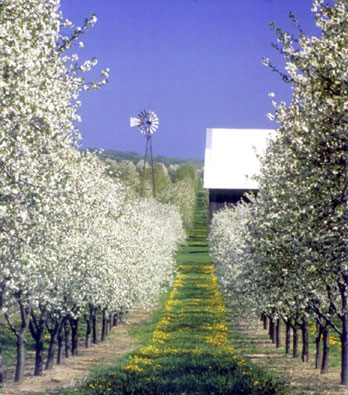Pollination

Fruit crops depend on the success of the flower development, pollination process, and fertilization during the growing season. At bloom, bees are brought into the orchard to facilitate the transfer of pollen and to improve the pollination process. On average, there are 3 hives per 10 acres. Hives are put into place a few days before full bloom.
Weather-related factors like low temperatures and rainy or foggy conditions have a negative effect on the release and transfer of the pollen. Bees exhibit very little activity below 12ºC. Winds greater than 25 km h-1 and precipitation will also decrease bee activity, resulting in a poor pollination process (Thomson, 1996).
Four general requirements need to be satisfied for a successful pollination and fertilization:
1) Availability of an adequate source of viable, compatible pollen;
2) Effective transfer of pollen at the time of time of stigma receptivity;
3) Growth of pollen tubes down into the style and enter the ovule during the period that embryo sacs have matured and ovules are viable;
4) Double fertilization and subsequent growth and development of embryo and endosperm must occur (Thomson, 1996).
Source: Beedy T., C. Zavalloni, T. Wright, N. Rothwell, J. Nugent, S. Thornsbury and J.R. Black. 2005. "Cost to produce tart cherry in Michigan.” Risk Management Assessment Joint Report of UC Davis and Pileus Project. First draft under revision.
Thomson M. 1996. Flowering, Pollination and Fruit Set. From: “Cherries: Crop Physiology Production and Uses”, A.D. Webster and N.E. Looney Eds., CAB International, pp. 230-235.
NEXT TOPIC: Relative yield![]()
PEVIOUS TOPIC: Bud loss due to cold injury![]()
LIST OF THE TOPICS IN THIS SECTION (Tart Cherry Development and Production)
- Previous year's moisture
- Dormancy
- Growing degree days (GDDs)
- Side green
- Bloom
- Bud loss due to cold injury
- Pollination (You are here)
- Relative yield